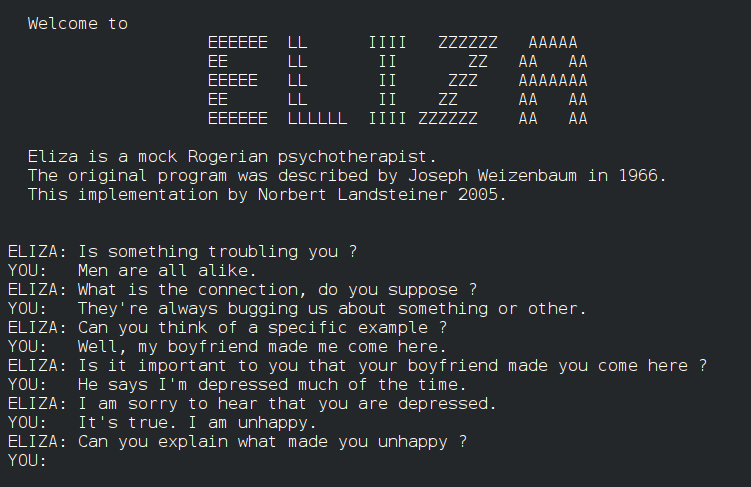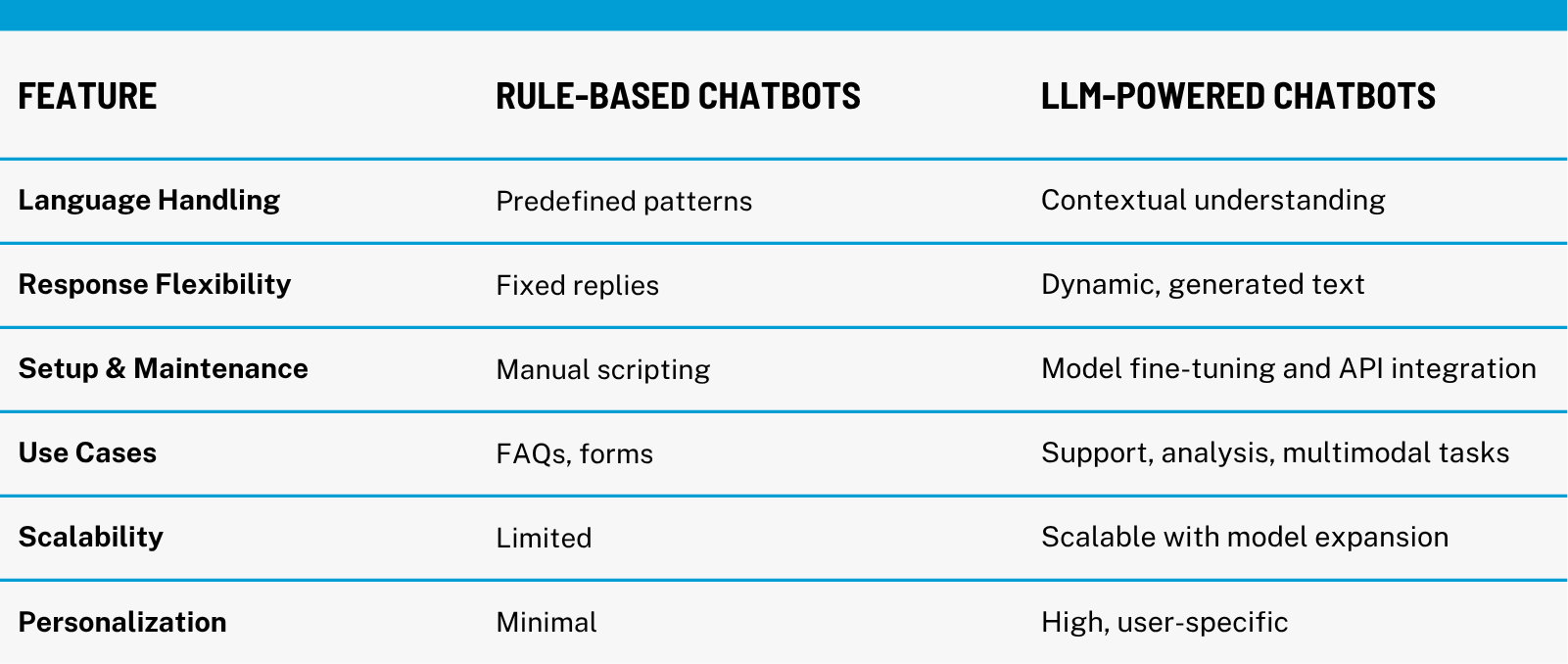The journey of chatbots mirrors the broader evolution of AI: from inflexible scripts to adaptive assistants powered by advanced models. Today, the global AI chatbot market is valued at approximately $15.6 billion, projected to grow to $46.6 billion by 2029, at a compound annual growth rate (CAGR) of around 24%. With nearly a billion users interacting with AI chatbots, they’ve become indispensable tools in customer engagement.
When you combine that rapid growth with the rise of Generative AI, it’s clear we’re no longer talking about rule-based auto-responders. Today’s chatbots are conversation partners, solutions capable of understanding, adapting, and now even reasoning. While chatbots are now only a part of what NLP and LLM can do, it’s worth recognizing how we got to this moment. This piece digs into the evolution of chatbot technology, showcasing the roadmap from basic scripts to complex LLM-powered assistants, and what this evolution can mean for your organization.
Phase 1: Rule-Based Chatbots
The earliest chatbot systems, emerging in the 1960s and gaining traction through the 1990s, were built entirely around explicit rules. If you typed “hello,” the bot replied, “Hello, how can I help?” Fundamental examples include ELIZA (MIT, 1966) and its successor PARRY (Stanford, 1972). ELIZA simulated a Rogerian therapist by spotting keywords in user input and inserting them into prewritten templates, creating the illusion of understanding, a phenomenon later known as the “ELIZA effect”.
These early bots were essentially flowcharts in code. Their simplicity made them quick to deploy: they required no training on data, just thoughtfully crafted scripts. This simplicity also meant easy maintenance and straightforward integration, for example, serving information-heavy industries by guiding users through decision trees.
However, that same rigidity limited their usefulness. Rule-based chatbots lacked learning capability, needed explicit updates for each new question, and often stumbled over variations in phrasing. They were brittle, unable to handle unexpected input, and often ended in frustration or a default message like “I’m not sure.” Such behavior made them ill-suited for complex customer journeys.

Phase 1 chatbots laid the groundwork, but the stage was set for more adaptive, context-aware systems, and that brings us to the rise of NLP-powered bots in the next phase.
Phase 2: NLP‑Powered Chatbots
In the early 2010s, chatbot platforms such as Dialogflow, Rasa, and Watson Assistant introduced a leap forward by incorporating Natural Language Understanding (NLU) capabilities, most notably intent classification and entity extraction. These bots could interpret a sentence like “Book me a flight to Paris next Tuesday” by identifying the user’s intent (e.g., “book_flight”) and key entities (city: “Paris”, date: “next Tuesday”), with up to 84 % accuracy on intent classification tasks across platforms .
Under the hood, these systems used machine learning models such as CRFs and, more recently, transformers to classify phrases into intents and extract meaningful fields (Named Entity Recognition – NER). They also enabled developers to build with modular NLP components, which improved flexibility and maintainability. For example, you could define “book_flight” intent and slot fields separately, then map them to structured queries for back‑end systems, which was much cleaner than hard-coded flows.
This shift also allowed NLP development services to flourish, offering custom intent models, domain-specific entity recognition, and integration with enterprise systems. Anchored by NLU, chatbots became more conversational, capable of handling rephrased utterances, minor grammatical variations, and multilingual inputs.
NLP-powered bots added:
- Intent Classification made bots understand where the user was heading, even with natural phrasing.
- Named Entity Recognition (NER) extracted critical data like names, dates, and product types from freeform input.
- Slots & Dialogue Management allowed bots to handle context and multi-step flows naturally.
Why did it matter?
Pre-NLP tools often missed user goals when phrasing changed. With NLU, bots could map similar requests to structured intents, handle variations, and manage follow-up questions, making interactions less brittle and more useful. Developers also benefited from lower maintenance overhead and easier support for new intents (like “cancel appointment” or “check order status”).
This transition laid the foundation for modern chatbots that don’t just follow scripts, but understand your words.
Phase 3: LLM-Powered Chatbots
The introduction of Large Language Models (LLMs), such as GPT‑3/4, Claude, and Gemini, marked a major shift in chatbot capabilities. These models are pre-trained on massive datasets and fine-tuned to generate coherent, context-aware text, enabling bots to engage in fluid, unscripted dialogue.
Key Opportunities:
- Contextual continuity: Instead of resetting with each user input, LLM bots maintain memory of previous exchanges, enabling more natural and cohesive conversations.
- Few-shot prompting: By including examples in the prompt, LLMs can learn specific tasks on the fly, like formatting invoices or summarizing emails, without extensive training.
- Dynamic language generation: Responses are not pre-coded. LLMs adapt and elaborate based on the prompt, offering richer and more flexible interactions.
Real-World Challenges
Despite their strengths, LLM chatbots aren’t flawless. They are prone to hallucinations, creating plausible yet false information. Studies report hallucination rates of 27–46% in generated outputs. To counter this, LLM software developers use methods like Retrieval-Augmented Generation (RAG) to ground responses in real data, and chain-of-thought prompting to steer accuracy.
Modern Use Cases: Where LLM-Powered Chatbots Deliver Value
Today’s AI chatbots are multi-functional agents embedded in business-critical workflows. Across industries, LLM-based systems are used not only to chat but to reason, retrieve, summarize, generate, and route information with measurable impact.
Healthcare
AI chatbots triage symptoms, schedule appointments, and extract relevant parts of patient records using NLP-powered retrieval. LLMs can assist in generating draft discharge summaries, answering clinical staff queries, and simplifying patient communication, all while being tailored for HIPAA compliance.
Healthcare AI solutions can enhance the level of care and reduce the routine workload that doctors and other hospital staff face daily, along with the need to focus on the health and well-being of their patients.
Education
In education platforms, generative chatbots act as language tutors, quiz creators, or writing support tools. They adapt to student proficiency levels, offer contextual feedback, and support multiple languages, making them valuable in both formal instruction and self-paced learning.
The types of solutions that learning and classic education can receive through the implementation are numerous now, and you can learn more about LLMs and AI in Education software on a dedicated page.
Enterprise Support
In CRMs and help desks, LLM bots enable context-aware ticketing systems that go beyond scripted answers. Enterprise AI solutions benefit from these bots that summarize conversation history, generate ticket replies, route complex cases, and offer suggestions, reducing resolution time and agent fatigue.
Customer Support
In customer-facing roles, LLM chatbots power ticketing systems, knowledge base search, and response drafting, among many other industry-specific applications. Unlike their rule-based predecessors, they understand context, adjust tone, and handle edge cases, helping human agents resolve issues faster and more consistently, while leaving more manpower available to tackle complex urgent problems, delegating simpler issues to AI.
A great example comes from our work with a home repair support platform. The company connects homeowners with qualified technicians for appliance repairs. We helped them implement an AI-driven multimodal chatbot that could interpret user-submitted text, images, and even videos to diagnose household issues like leaks, blocked vents, or AC malfunctions. The bot handled common problems independently and flagged more complex cases for human experts, cutting manual load and improving support speed.
Internal Operations
Many companies now deploy internal LLM assistants that, among other things:
- Generate and refine reports
- Summarize company documentation
- Help employees navigate internal processes or compliance
- Execute automated tasks via API connections
These bots act less like “chat” tools and more like internal copilots, answering real-time queries with system-aware intelligence. It can already simplify onboarding, cut time spent on processing tickets, help navigate complex internal structures, and much more. High flexibility and the option to train a custom LLM allow for a near-unlimited level of complexity and automation.

Challenges & Limitations of LLM Chatbots
While LLM-driven chatbots offer impressive flexibility and natural conversation, they come with significant challenges. Understanding these is essential to deploying them responsibly and effectively.
Hallucinations & Misinformation
LLMs can confidently present false or fabricated information. As mentioned previously in the article, the hallucination rate is pretty significant. In testing and research, the models performed strongly when working with memorized content, highlighting the need to train niche-specific LLMs and utilize Retrieval-Augmented Generation (RAG) to help ground outputs in verified data.
Scalability & Performance Constraints
Deploying LLMs at scale requires substantial computational power. Models with hundreds of billions of parameters often need distributed GPU clusters; latency, throughput, and cost become serious concerns. Scaling demands advanced infrastructure and expert management. While this problem will barely be felt within small and medium-sized organizations, enterprise AI customers will definitely have to address it sooner or later.
Integration Gaps
LLMs operate best when contextualized within systems, whether CRMs, knowledge bases, or analytics tools. Without tight integration, chatbot responses may be generic, irrelevant, or stale. Successful systems embed LLMs deeply into workflows, making them true assistants rather than isolated tools. To avoid the associated issues, companies must approach AI integration with full seriousness and due diligence.
Privacy & Compliance Risks
Any LLM chatbot handling sensitive data like customer info or financial details must be designed with robust privacy measures. That includes strict control over processing environments, encryption, and data handling protocols to meet HIPAA, GDPR, and other regulations.
Lack of Explainability
Large models function as “black boxes,” making it difficult to trace why certain responses are generated and, consequently, to address any mistakes and hallucinations. This opacity can create trust barriers in regulated environments like finance, law, and healthcare.
Knowledge Drift & Maintenance Needs
LLMs trained on static data can become outdated. Information changes, company policies evolve, and AI must be retrained or fine-tuned continuously to remain accurate. Without regular updates, these bots risk becoming obsolete.
So What Now?
Mitigating these limitations typically involves a hybrid approach:
- Combine LLMs with grounded data via RAG pipelines
- Employ small domain-specific models (SLMs) for critical functions
- Plan for scalable compute, integrated data pipelines, and ongoing maintenance
- Implement privacy-first architectures and monitoring for hallucinations
These strategies help bring the transformative benefits of LLM chatbots into real-world business operations, without being derailed by their limitations.
The Takeaway
AI chatbots have come a long way, from stiff, rule-based responders to fluid, LLM-powered assistants capable of understanding nuance, handling multimedia, and automating meaningful parts of business workflows.
But this evolution also comes with responsibility. LLM chatbots are not one-size-fits-all tools; they require proper integration, safeguards, and a clear understanding of their limits. When deployed thoughtfully, they unlock real impact: reducing support backlog, accelerating responses, and enhancing user experience across industries.
At SEVEN, we help businesses navigate this landscape. Whether you’re building your first LLM-powered chatbot, upgrading legacy systems, or exploring multimodal capabilities, we can support you with:
- Strategic planning and model selection
- Custom LLM development and fine-tuning
- Integration with internal tools and CRMs
- Privacy and compliance-ready deployments
Want to explore how conversational AI can work for your business without the guesswork?